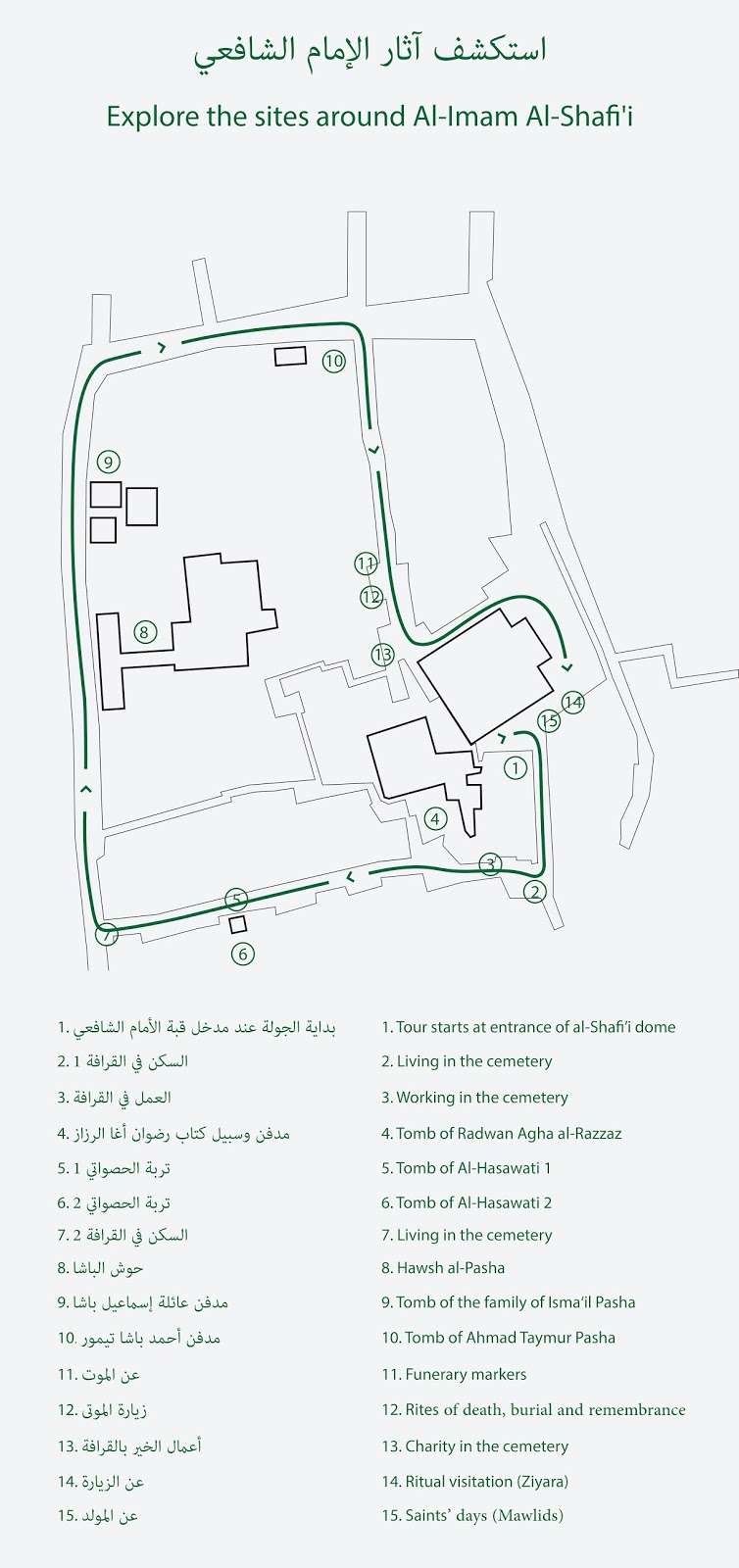مدفن عائلة إسماعيل باشا / Tomb of the family of Isma‘il Pasha
مدفن عائلة إسماعيل باشا (معروف باسم مدفن البرنس محمود حمدي)
التاريخ: قبل 1872
المؤسس: الخديوي إسماعيل
الوظيفة: مدفن عائلة الخديوي إسماعيل به مدافن زوجتيه بزم (1872) وجمال نور (1876)
هذا الضريح الواقع شمال حوش الباشا مباشرة، بناه إسماعيل باشا (حكم مصر من 1863-1879) حفيد محمد على باشا، وخامس حاكم من أسرة محمد على. واستطاع أن يحصل لمصر على قدر كبير من الحكم الذاتي من الباب العالي في 1867 كخديوي مصر والسودان. وتظهر بصمة الخديوي إسماعيل على مناطق كثيرة بالقاهرة. فبينما قام من سبقه بتمهيد المنطقة بين المدينة والنيل وإزالة التلال، والبناء والتخضير، كان للخديوي إسماعيل الفضل في تأسيس الإسماعيلية، مركز المدينة الجديد، هناك. تم تقسيم الحي وتخصيص الأراضي للأرستقراطية المصرية الذين بنوا قصورهم هناك، كما قام المستثمرون الآجانب ببناء مباني لشقق سكنية على الطريقة الأوروبية ومباني تجارية.
رغم أن الخديوي اسماعيل نفسه مدفون في مسجد الرفاعي، إلا أن زوجتيه بزم (1872) وجمال نور (1876) مدفونتان في هذا الضريح، بالإضافة إلى إبنه الأمير محمود حمدي (1921) وآخرين من العائلة. الحوش لحالي يتكون من ست مباني، أحدهما قبه، وبه أيضًا سبيل صغير
المؤسس: الخديوي إسماعيل
الوظيفة: مدفن عائلة الخديوي إسماعيل به مدافن زوجتيه بزم (1872) وجمال نور (1876)
هذا الضريح الواقع شمال حوش الباشا مباشرة، بناه إسماعيل باشا (حكم مصر من 1863-1879) حفيد محمد على باشا، وخامس حاكم من أسرة محمد على. واستطاع أن يحصل لمصر على قدر كبير من الحكم الذاتي من الباب العالي في 1867 كخديوي مصر والسودان. وتظهر بصمة الخديوي إسماعيل على مناطق كثيرة بالقاهرة. فبينما قام من سبقه بتمهيد المنطقة بين المدينة والنيل وإزالة التلال، والبناء والتخضير، كان للخديوي إسماعيل الفضل في تأسيس الإسماعيلية، مركز المدينة الجديد، هناك. تم تقسيم الحي وتخصيص الأراضي للأرستقراطية المصرية الذين بنوا قصورهم هناك، كما قام المستثمرون الآجانب ببناء مباني لشقق سكنية على الطريقة الأوروبية ومباني تجارية.
رغم أن الخديوي اسماعيل نفسه مدفون في مسجد الرفاعي، إلا أن زوجتيه بزم (1872) وجمال نور (1876) مدفونتان في هذا الضريح، بالإضافة إلى إبنه الأمير محمود حمدي (1921) وآخرين من العائلة. الحوش لحالي يتكون من ست مباني، أحدهما قبه، وبه أيضًا سبيل صغير
 |
للدخول الي اللعبة أضغط هنا |
Tomb of the family of Isma‘il Pasha (currently known as Madfan of Prince Mahmud Hamdi)
Date: before 1872
Founder: probably Khedive Isma‘il
Function: Tomb for Khedive Isma‘il’s family. The first documented burials were his wives Buzum (1872) and Jamal Nur (1876)
This mausoleum, immediately to the north of Hawsh al-Pasha, was built by Isma‘il Pasha (r. 1863-1879), grandson of Muhammad ‘Ali Pasha and fifth ruler of the dynasty, who managed to achieve considerable autonomy from the Ottoman Porte in 1867 as Khedive of Egypt and Sudan. Ismá`íl Pasha’s stamp can still be seen today on most of Cairo. While his predecessors had paved the path by clearing the area between the existing city and the Nile, removing mounds, building and planting open areas, it was Ismá`íl who created the new city centre of al-Ismá`íliyya there. It was sectioned off and allotted to the Egyptian aristocracy, who built their palaces there, and more importantly, to foreign investors who created European style apartment buildings and commercial structures. Although Isma‘il himself is buried at the Mosque of al-Rifa‘i, two of his wives, Buzum and Jamál Núr, were buried here in 1872 and 1876 respectively, as well as his son, Prince Mahmud Hamdi (d.1921) and other members of the family. The current enclosure consists of six buildings, one of which is domed, and a sabil.
Founder: probably Khedive Isma‘il
Function: Tomb for Khedive Isma‘il’s family. The first documented burials were his wives Buzum (1872) and Jamal Nur (1876)
This mausoleum, immediately to the north of Hawsh al-Pasha, was built by Isma‘il Pasha (r. 1863-1879), grandson of Muhammad ‘Ali Pasha and fifth ruler of the dynasty, who managed to achieve considerable autonomy from the Ottoman Porte in 1867 as Khedive of Egypt and Sudan. Ismá`íl Pasha’s stamp can still be seen today on most of Cairo. While his predecessors had paved the path by clearing the area between the existing city and the Nile, removing mounds, building and planting open areas, it was Ismá`íl who created the new city centre of al-Ismá`íliyya there. It was sectioned off and allotted to the Egyptian aristocracy, who built their palaces there, and more importantly, to foreign investors who created European style apartment buildings and commercial structures. Although Isma‘il himself is buried at the Mosque of al-Rifa‘i, two of his wives, Buzum and Jamál Núr, were buried here in 1872 and 1876 respectively, as well as his son, Prince Mahmud Hamdi (d.1921) and other members of the family. The current enclosure consists of six buildings, one of which is domed, and a sabil.
 |
Click Here To Play |

